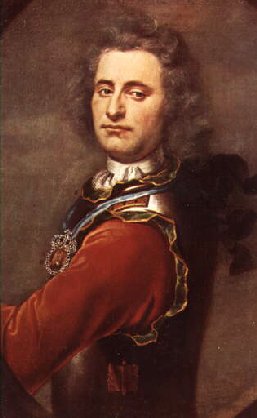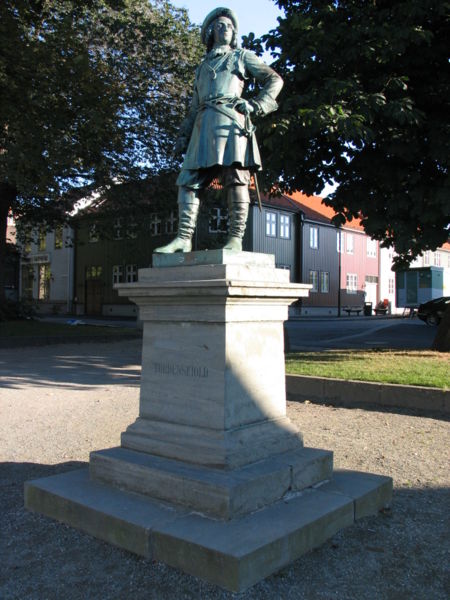<Back to Index>
- Philosopher Desiderius Erasmus Roterodamus, 1466/69
- Painter Giovanni Antonio Canal (Canaletto), 1697
- Vice-Admiral Peter Jansen Wessel (Tordenskjold), 317
PAGE SPONSOR


Peter Jansen Wessel, better known as Tordenskjold (lit. "thundershield"), (October 28, 1691 – November 12, 1720), was an eminent Norwegian naval officer in the service of the King of Denmark-Norway. He rose to the rank of Vice-Admiral in the Royal Dano-Norwegian Navy for his services in the Great Northern War.
Born in Trondheim, Peter Wessel travelled to Copenhagen in 1704, and was employed in the navy. He won a name for himself through audacity and courage, and was ennobled as Peter Tordenskjold by king Frederick IV of Denmark in 1716. His greatest exploit came later that year, as he destroyed the supply fleet of Charles XII of Sweden at the Battle of Dynekilen. In 1720, he was killed in a duel. In Denmark as well as in Norway he is probably considered the most famous naval hero, and he is featured in the national anthems of both countries. His was an unusually successful rise in rank, considering he died when he was only 29 years old.
Born in Trondheim in Norway, he was the tenth child of alderman Jan Wessel, and the brother of later Rear-Admiral Caspar von Wessel. Peter Wessel was a wild, unruly lad who gave his pious parents much trouble, eventually stowing away on a ship heading for Copenhagen in 1704. In Copenhagen, he unsuccessfully sought to become a navy cadet. He befriended the king's chaplain Dr Peder Jespersen who sent Wessel on a voyage to the West Indies, and finally procured for him a vacant cadetship. After further voyages, this time to the East Indies, Wessel was appointed Second Lieutenant in the Royal Danish-Norwegian Navy on July 7, 1711, and went on to serve on the frigate Postillion. While on Postillion, he befriended Norwegian admiral baron Waldemar Løvendal, who was the first to recognize the young man's potential as a naval officer. Løvendal soon made Peter Wessel the captain of the 4-gunsloop Ormen (HMS Serpent).
Wessel started his navy service during the Great Northern War against Sweden, cruising about the Swedish coast in Ormen picking up useful information about the enemy. In June 1712, Løvendal promoted him to the 18-gun frigate Løvendals Gallej, against the advice of the Danish admiralty, who considered Wessel unreliable. After officially complaining about his dreary commanding officer Daniel Jacob Wilster in Norway, Wessel was transferred to the Baltic Sea command of Ulrik Christian Gyldenløve, who appreciated and utilized Wessel's courage. Wessel was already renowned for two things: the audacity with which he attacked any Swedish vessels he came across regardless of the odds, and his unique seamanship, which always enabled him to evade capture.
The Great Northern War had now entered upon its later stage, when Sweden, beset on every side by foes, employed her fleet principally to transport troops and stores to the distressed Swedish Pomerania provinces.
The audacity of Wessel impeded her at every point. He was continually
snapping up transports, dashing into the fjords where her vessels lay
concealed, and holding up her detached frigates. He was a part of Gyldenløve's fleet which succeeded in destroying a large number of Swedish transport ships at Rügen on September 29, 1712, and was promoted from Second Lieutenant to Captain Lieutenant. His successes compelled the Swedes to post a reward for his capture, while his free and easy ways also won him enemies in the Danish navy, who deplored his almost Privateer-like conduct. In 1714, Tordenskjold was court-martialled after
an indecisive sea battle with a Swedish frigate. The account of the
incident is verified by the legal proceedings from November 1714. On
July 26, 1714, he encountered a frigate under English flag near Lindesnes, while flying a Dutch flag on the Løvendals Gallej himself. The other frigate was De Olbing Galley carrying 28 guns, which had been equipped in England for the Swedes and was on its way to Gothenburg under the command of an English captain named Bactmann. De Olbing Galley signalled for Løvendals Gallej to come closer, and as Wessel raised the Danish flag, Bactmann fired a broadside at him. In the English captain, Wessel met a tough match. The combat lasted all day, and when De Olbing Galley tried to escape in the evening, Wessel set more sails and continued the duel. The fight was interrupted by nightfall, and renewed again indecisively the following morning. Both
ships were badly damaged after around 14 hours of fighting, when Wessel
was running out of ammunition. He then sent an envoy to the English
ship, cordially thanking the English for a good duel, and asked if he
could borrow some of their ammunitions in order to continue the fight.
His request was denied, and the captains drank to each other's health,
before the ships dispersed. When he heard of the incident, king Frederick IV of Denmark asked for the admiralty to court-martial Wessel. He
stood trial in November 1714, accused of disclosing vital military
information about his lack of ammunition to the enemy, as well as
endangering the ship of king Frederick IV by fighting a superior enemy
force. The
spirit with which he defended himself and the contempt he poured on his
less courageous comrades took the fancy of Frederick IV. He
successfully argued a section of the Danish naval code which mandated
attacking fleeing enemy ships no matter the size, and was acquitted on
December 15, 1714. He then went to the king asking for a promotion, and
was raised to the rank of Captain on December 28, 1714. When, in 1715, the return of King Charles XII of Sweden from Turkey to Stralsund put
new life into the dispirited Swedish forces, Wessel distinguished
himself in numerous engagements off the coast of Swedish Pomerania, under the command of Admiral Christian Carl Gabel. He did the enemy considerable damage by cutting out his frigates and destroying his transports. During a battle at Kolberg on April 24, 1715, Wessel captured the Swedish Rear-Admiral Hans Wachtmeister, as well as the frigate Vita Örn (White Eagle), which he was granted as his new flagship under the name Hvide Ørn. He then transferred to the main fleet under the command of Peter Raben. On returning to Denmark in the beginning of 1716 he was ennobled by Frederick IV under the name of Tordenskjold ("Thundershield"). When in the course of 1716, Charles XII invaded Norway and laid siege to the fortress of Fredrikshald,
Tordenskjold compelled him to raise the siege and retire to Sweden. He
did so by pouncing upon the Swedish transport fleet, laden with
ammunition and other military stores, which rode at anchor in the
narrow and dangerous Dynekil Fjord. With two frigates and five smaller ships, he conquered or destroyed around 30 Swedish ships, with little damage to himself during the Battle of Dynekilen on July 8, 1716. For this his greatest exploit, he was promoted to the rank of Post-Captain, commanding the Kattegat squadron
- but at the same time incurred the enmity of Christian Carl Gabel,
whom he had failed to take into his confidence. Tordenskjold's first
important command was the squadron with which he was entrusted in the
beginning of 1717 for the purpose of destroying the Swedish Gothenburg
squadron, which interrupted the communications between Denmark and
Norway. Owing to the disloyalty of certain of his officers who resented
serving under the young adventurer, Tordenskjold failed to do all that
was expected of him. His enemies were not slow to take advantage of his
partial failure. The old charge of criminal recklessness was revived
against him at a second court-martial before which he was summoned in
1718, but his old patron Ulrik Christian Gyldenløve intervened
energetically on his behalf, and the charge was quashed. In
December 1718, Tordenskjold brought to Frederick IV the welcome news of
the death of Charles XII and was in turn made Rear-Admiral. Tordenskjold captured the Swedish fortress of Carlsten at Marstrand in 1719. The
last feat of arms during the Great Northern War was Tordenskjold's
partial destruction and partial capture of the Gothenburg squadron
which had so long eluded him, on September 26, 1719. He was rewarded
with the rank of Vice-Admiral. Tordenskjold did not long survive the termination of the war. On November 12, 1720, at the age of 29, he was killed in a duel by Livonian colonel Jakob Axel Staël von Holstein. During a trip to Hannover, Tordenskjold got in a fight with Staël, who had been in Swedish military service. The confrontation ended in a duel near Hildesheim, in which Tordenskjold was run through by the sword of Staël. The
circumstances around the death of Tordenskjold was set in a
conspirational light, as summed up in the contemporary three volume
Tordenskjold biography (1747–1750) by C. P. Rothe. The
duel was encouraged by a dispute with Staël, whom Tordenskjold
offended by labeling him as a cheater at gambling. At a dinner party,
Tordenskjold told of a friend who had been cheated while gambling with
a man who claimed to own a Hydra,
to which Staël announced he was the owner of the said creature and
took offence at being called a cheater. This dispute turned into a
fight, in which Stäel unsuccessfully tried to pull a sword, after
which Tordenskjold used the pommel of his own sword to beat him up.
Stäel demanded satisfaction through a duel, and it was agreed that
it was to be fought with pistols, a weapon that Tordenskjold was very skilled with. On the day of the duel, Tordenskjold's assigned second tricked
him into thinking Stäel had forfeited and left town, and convinced
him to leave his firearms at home. When he arrived at the duelling
field to win by default, Staël was waiting for him, and the duel
would have to be fought with swords. Tordenskjold refused to back out,
even though his sword was inferior. Tordenskjold only had his ceremonial rapier, whereas von Holstein was armed with a solid steel longsword (called
a "Karolinerverge", a "Carolean sword"). Tordenskjold was run through
by his adversary, the blow slicing two arteries wide open. He stumbled
a couple of steps backwards, and died in the arms of his servant Kold. His corpse was brought to Copenhagen to the Church of Holmen without much ceremony, as duelling was not allowed according to Danish law of the time. In 1819, he was buried in a sarcophagus.